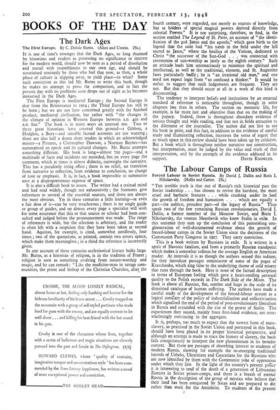BOOKS OF THE DAY
The Dark Ages
The First Europe. By C. Delisle Burns. (Allen and Unwin. 25s.) IT is one of time's revenges that the Dark Ages, so long shunned by historians and readers as possessing no significance or interest for the modern world, should now be seen as a period of dissolution and travail with resemblances to our own age, and should be scrutinised anxiously by those who feel that now, as then, -a whole phase of culture is slipping away, to yield place—to what? Some such conviction as this led Mr. Burns to write this book, though he makes no attempt to press the comparison, and in fact the present day with its problems soon drops out of sight as he becomes immersed in the Dark Ages. The First Europe is mediaeval Europe ; the Second Europe is that from the Renaissance to 1914; the Third Europe has still to be born ; but we are not here concerned greatly with the finished product, mediaeval civilisation, but rather with "the changes in the climate of opinion in Western Europe between A.D. 400 and A.D. 800." The book is in many ,.ways an unusual one. Two or three great historians have covered this ground—a Gibbon, a Hodgkin, a Bury—and sizeable factual accounts are not wanting ; there are also half a dozen short studies in which an acknowledged master—a Pirenne, a Christopher Dawson, a Norman Baynes—has summarised an epoch and its cultural changes. Mr. Burns attempts something different. His book is long-a-almost 700 pages—and a multitude of facts and incidents are recorded, but on every page the comment, which at times is almost didactic, outweighs the narrative. This has a peculiarly tiring effect ; there is no relief, no transition from narrative to reflection, from evidence to conclusion, no change of tone or emphasis. It is, in fact, a book impossible to summarise save at a disproportionate expense of space.
It is also a difficult book to assess. The writer had a trained mind and had read widely, though not exhaustively ; the footnotes give references to several of the essential sources, and those not always. the most obvious. Yet in these centuries a little learning—or even a fair dose of it—can be very treacherous ; there is no single guide or group of guides, and on almost every page a specialist will wish for some assurance that this or that source or scholar had been con- stilted and judged before the pronouncement was made. The range of references is wide, but the selection is arbitrary, and the reader is often left with a suspicion that they have been taken at second hand. Aquinas, for example, is cited, somewhat needlessly, four times ; two of the quotations, as printed, contain two errors apiece, which make them meaningless ; in a third the reference is incorrectly given.
In any account of these centuries ecclesiastical history bulks large. Mr. Burns, as a historian of religion, is in the tradition of Frazer ; religion is seen as something evolving from nature-worship and magic, and he can remark: "Like the medicine-man in savage com- munities, the priest and bishop of the Christian Churches, after. the fourth century, were regarded, not merely as sources of knowledge, but as holders of special magical powers derived directly front celestial Powers." It is not surprising, therefore, to find, in the section entitled The Legend of Sr. Peter, an account of "the identi- fication of the god Janus and the apostle," which gave birth to the legend that the saint had "his tomb in the field under the hill sacred to Janus," where the basilica of the Vatican, dedicated to Christ "the successor of the Sun-God . . . was connected with ceremonies of sun-worship as lately as the eighth century." Such an attitude leads him unconsciously to minimise the spiritual and intellectual, as well as the traditional, element, and St. Augustine faxes particularly badly ; he is "an irrational old man," and one need not expect logic from "so confused a thinker." It would be unfair to suggest that such judgements are frequent. They are not. But that they should occur at all in a work of this kind is disconcerting.
The tendency to interpret beliefs and institutions by an external standard of reference is noticeable throughout, though in some chapters less than in others. The section on monastic life for example, is far more, just and objective than that on the making of the papacy. Indeed, there is throughout abundant evidence of serious thought and wide reading, and that not in fields attractive to the dilettante or the journalist. The author did not live to see his book in print, and this fact, in addition to the evidence of careful study and illuminating reflection, increases the sense of regret that so much space in this review should have been taken up by criticism. But a book which is throughout neither narrative nor .construction, but interpretation, must be judged by the value and truth of that interpretation, and by the strength of the evidence adduced in its


































 Previous page
Previous page